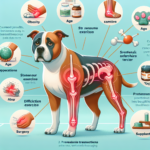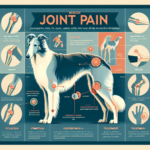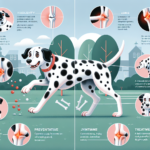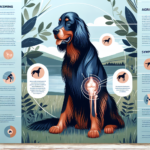Old English Sheepdog Joint Pain: Causes, Symptoms, Prevention, and Treatment
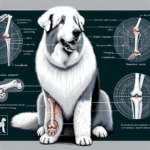
Introduction
The Old English Sheepdog, often affectionately referred to as the “Bobtail,” is a breed known for its distinctive shaggy coat and amiable personality. Originating in England, this breed was initially developed for herding sheep and cattle. With its robust build and playful demeanor, the Old English Sheepdog has become a beloved family pet and show dog. However, like many large breeds, it is prone to certain health issues, particularly joint pain.
Joint health is a critical concern for Old English Sheepdogs due to their size and genetic predispositions. Joint pain can significantly impact their quality of life, making it essential for owners to be aware of the causes, symptoms, prevention, and treatment options available.
Breed-Specific Joint Pain Risks
Genetic Predisposition
Old English Sheepdogs are genetically predisposed to several joint-related issues. Hip dysplasia, a condition where the hip joint doesn’t fit properly into the hip socket, is common in this breed. Elbow dysplasia, where the elbow joint is malformed, and arthritis, a degenerative joint disease, are also prevalent. These conditions can lead to chronic pain and mobility issues if not addressed promptly.
Age-Related Risks
As Old English Sheepdogs age, the risk of joint pain increases. Typically, signs of joint issues may start to appear as early as five to six years old. It’s crucial for owners to monitor their dogs for any changes in mobility or behavior as they age, as early detection can lead to more effective management.
Activity Level and Joint Stress
Old English Sheepdogs are active and energetic, often enjoying activities like running, playing, and herding. While regular exercise is essential for their overall health, excessive or high-impact activities can put additional stress on their joints. Owners should balance their dog’s activity level to prevent overexertion and potential joint damage.
Common Symptoms of Joint Pain in Old English Sheepdogs
General Symptoms
- Limping or favoring one leg
- Stiffness, especially after resting
- Reluctance to climb stairs or jump
- Decreased activity or playfulness
- Visible discomfort or pain when touched
Breed-Specific Symptoms
In Old English Sheepdogs, joint pain may manifest as a reluctance to engage in activities they once enjoyed, such as herding or playing fetch. They may also show signs of discomfort when getting up from a lying position or exhibit a noticeable change in their gait.
When to Consult a Vet
If you notice any of the above symptoms in your Old English Sheepdog, it’s essential to consult a veterinarian. Early intervention can prevent further deterioration and improve your dog’s quality of life. Regular veterinary check-ups are also crucial for monitoring joint health and catching any issues early.
Preventive Measures for Joint Health
Exercise Recommendations
Regular, low-impact exercise is vital for maintaining joint health in Old English Sheepdogs. Activities like swimming, walking, and gentle play can help keep their joints flexible and muscles strong without causing excessive stress. Avoid high-impact activities like jumping or running on hard surfaces.
Dietary Suggestions
A balanced diet rich in essential nutrients can support joint health. Look for dog foods that contain glucosamine and chondroitin, which are known to promote joint health. Omega-3 fatty acids, found in fish oil supplements, can also help reduce inflammation and support overall joint function.
Weight Management
Maintaining a healthy weight is crucial for reducing joint stress. Excess weight can exacerbate joint issues and lead to more severe pain. Monitor your dog’s weight and adjust their diet and exercise routine as needed to keep them at an optimal weight.
Early Screening and Monitoring
Regular veterinary check-ups and early screening for joint issues can help catch problems before they become severe. X-rays and other diagnostic tests can identify joint abnormalities early, allowing for more effective management and treatment.
Treatment Options for Joint Pain
Non-Surgical Treatments
Non-surgical treatments for joint pain in Old English Sheepdogs include medications, physical therapy, and lifestyle adjustments. Anti-inflammatory medications and pain relievers can help manage pain and reduce inflammation. Physical therapy, including exercises and massage, can improve mobility and strengthen muscles around the joints.
Surgical Options
In severe cases, surgical intervention may be necessary. Common surgeries for joint issues in Old English Sheepdogs include hip replacement, arthroscopy, and joint fusion. These procedures can significantly improve mobility and reduce pain, but they come with risks and require a thorough discussion with your veterinarian.
Alternative Therapies
Alternative treatments like acupuncture, hydrotherapy, and massage can also benefit Old English Sheepdogs with joint pain. Acupuncture can help reduce pain and inflammation, while hydrotherapy provides low-impact exercise that can improve joint function. Massage can help relieve muscle tension and improve circulation.
Lifestyle and Management Tips
Daily Care Routine
A consistent daily care routine can help manage joint pain in Old English Sheepdogs. This routine might include gentle exercise, a balanced diet, and regular grooming to keep their coat and skin healthy. Incorporate joint supplements into their diet and ensure they have a comfortable place to rest.
Modifying the Home Environment
Making your home more comfortable for a dog with joint pain can significantly improve their quality of life. Consider adding ramps to help them navigate stairs, providing orthopedic beds for better support, and using non-slip mats to prevent falls on slippery surfaces.
Long-Term Management
Long-term management of joint pain involves regular veterinary check-ups, ongoing monitoring of symptoms, and adjustments to their care routine as needed. Keeping your Old English Sheepdog active and engaged with low-impact activities can help maintain their mobility and overall well-being.
FAQs About Old English Sheepdogs and Joint Pain
What are the early signs of joint pain in Old English Sheepdogs?
Early signs of joint pain include limping, stiffness, reluctance to move, and decreased activity levels. If you notice any of these symptoms, consult your veterinarian for a thorough evaluation.
Can joint pain in Old English Sheepdogs be prevented?
While genetic predispositions cannot be entirely prevented, maintaining a healthy weight, providing a balanced diet, and ensuring regular, low-impact exercise can help reduce the risk of joint pain.
Are there specific foods that can help with joint health?
Yes, foods rich in glucosamine, chondroitin, and omega-3 fatty acids can support joint health. Consult your veterinarian for dietary recommendations tailored to your dog’s needs.
When should I consider surgery for my dog’s joint pain?
Surgery is typically considered when non-surgical treatments are no longer effective, and the dog’s quality of life is significantly impacted. Your veterinarian can help determine the best course of action based on your dog’s condition.
Conclusion
Joint pain is a common issue in Old English Sheepdogs, but with proper care and attention, it can be managed effectively. By understanding the causes, symptoms, prevention, and treatment options, owners can help their dogs lead happy, active lives. Regular veterinary check-ups, a balanced diet, and appropriate exercise are key to maintaining joint health. If you notice any signs of joint pain in your Old English Sheepdog, consult your veterinarian promptly to ensure the best possible care for your furry friend.

